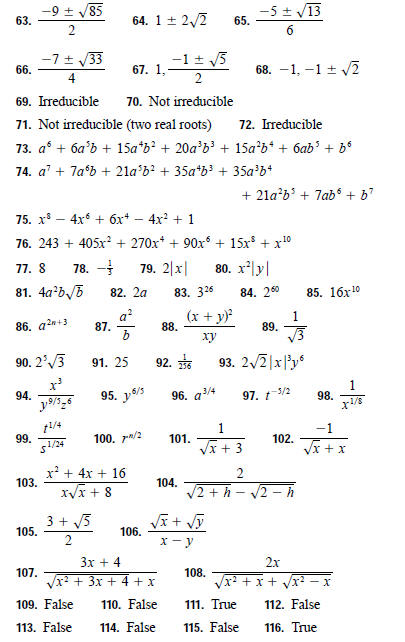Review of Algebra
Here we review the basic rules and procedures of algebra
that you need to know in
order to be successful in calculus.
Arithmetic Operations
The real numbers have the following properties:
 |
(Commutative Law) |
 |
(Associative Law) |
 |
(Distributive law) |
In particular, putting  in the Distributive Law, we get
in the Distributive Law, we get

and so

EXAMPLE 1

If we use the Distributive Law three times, we get

This says that we multiply two factors by multiplying each
term in one factor by each
term in the other factor and adding the products. Schematically, we have

In the case where  and
and
 , we have
, we have

or

Similarly, we obtain

EXAMPLE 2

Fractions
To add two fractions with the same denominator, we use the Distributive Law:

Thus, it is true that

But remember to avoid the following common error:

(For instance, take  to
see the error.)
to
see the error.)
To add two fractions with different denominators, we use a common denominator:

We multiply such fractions as follows:

In particular, it is true that

To divide two fractions, we invert and multiply:

EXAMPLE 3

Factoring
We have used the Distributive Law to expand certain
algebraic expressions. We sometimes
need to reverse this process (again using the Distributive Law) by factoring an
expression as a product of simpler ones. The easiest situation occurs when the
expression
has a common factor as follows:

To factor a quadratic of the form
 we note that
we note that

so we need to choose numbers
 so that
so that 
EXAMPLE 4 Factor

SOLUTION The two integers that add to give 5 and multiply
to give -24 are -3 and 8.
Therefore

EXAMPLE 5 Factor

SOLUTION Even though the coefficient of
 is not 1, we can still look for factors of
the
is not 1, we can still look for factors of
the
form  Experimentation reveals that
Experimentation reveals that

Some special quadratics can be factored by using Equations
1 or 2 (from right to
left) or by using the formula for a difference of squares:

The analogous formula for a difference of cubes is

which you can verify by expanding the right side. For a sum of cubes we have

EXAMPLE 6

EXAMPLE 7 Simplify

SOLUTION Factoring numerator and denominator, we have

To factor polynomials of degree 3 or more, we sometimes use the following fact.
6 The Factor Theorem If P is a polynomial and
 , then
, then  is
a factor
is
a factor
of 
EXAMPLE 8 Factor

SOLUTION Let  where b
is an integer, then
where b
is an integer, then
b is a factor of 24. Thus, the possibilities for b are

and  . We find that
. We find that
 By the Factor Theorem,
By the Factor Theorem,
 is a factor. Instead of substituting
further, we use long division as follows:
is a factor. Instead of substituting
further, we use long division as follows:

Therefore

Completing the Square
Completing the square is a useful technique for graphing
parabolas or integrating
rational functions. Completing the square means rewriting a quadratic

in the form  and can be accomplished by:
and can be accomplished by:
1. Factoring the number from the terms involving .
2. Adding and subtracting the square of half the coefficient of .
In general, we have

EXAMPLE 9 Rewrite
 by completing the square.
by completing the square.
SOLUTION The square of half the coefficient of x is 1/4. Thus

EXAMPLE 10

Quadratic Formula
By completing the square as above we can obtain the
following formula for the roots
of a quadratic equation
7 The Quadratic Formula
The roots of the quadratic equation

are

EXAMPLE 11 Solve the equation

SOLUTION With  the
quadratic formula gives the solutions
the
quadratic formula gives the solutions

The quantity  that
appears in the quadratic formula is called the
that
appears in the quadratic formula is called the
discriminant. There are three possibilities:
1. If  the equation has
two real roots.
the equation has
two real roots.
2. If  the roots are equal.
the roots are equal.
3. If  the equation has no real root. (The
roots are complex.)
the equation has no real root. (The
roots are complex.)
These three cases correspond to the fact that the number
of times the parabola
 crosses the -axis is 2, 1, or 0 (see Figure
1). In case (3) the quadratic
crosses the -axis is 2, 1, or 0 (see Figure
1). In case (3) the quadratic
 can’t be factored and is called irreducible.
can’t be factored and is called irreducible.

EXAMPLE 12 The quadratic
 is irreducible because its discriminant is
is irreducible because its discriminant is
negative:

Therefore, it is impossible to factor
 .
.
The Binomial Theorem
Recall the binomial expression from Equation 1:

If we multiply both sides by
 and simplify, we get the binomial expansion
and simplify, we get the binomial expansion

Repeating this procedure, we get

In general, we have the following formula.
9 The Binomial Theorem If is a positive integer, then
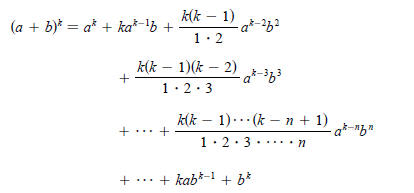
EXAMPLE 13 Expand

SOLUTION Using the Binomial Theorem with
 we have
we have

Radicals
The most commonly occurring radicals are square roots. The
symbol  means “the
means “the
positive square root of.” Thus

Since  , the symbol
, the symbol
 makes sense only when
makes sense only when
 Here are two rules
Here are two rules
for working with square roots:

However, there is no similar rule for the square root of a
sum. In fact, you should
remember to avoid the following common error:

(For instance, take  to
see the error.)
to
see the error.)
EXAMPLE 14

Notice that  because
because
 indicates the positive square root.
indicates the positive square root.
(See Appendix A.)
In general, if is a positive integer,

Thus  are not defined.
The following
are not defined.
The following
rules are valid:

EXAMPLE 15

To rationalize a numerator or denominator that contains an
expression such as
 we multiply both the numerator and the
denominator by the conjugate radical
we multiply both the numerator and the
denominator by the conjugate radical
 Then we can take advantage of the formula
for a difference of squares:
Then we can take advantage of the formula
for a difference of squares:

EXAMPLE 16 Rationalize the numerator in the expression

SOLUTION We multiply the numerator and the denominator by the conjugate radical


Exponents
Let be any positive number and let be a positive integer. Then, by definition,
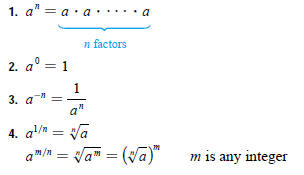
11 Laws of Exponents Let and be positive numbers
and let and be any
rational numbers (that is, ratios of integers). Then

In words, these five laws can be stated as follows:
1. To multiply two powers of the same number, we add the exponents.
2. To divide two powers of the same number, we subtract the exponents.
3. To raise a power to a new power, we multiply the exponents.
4. To raise a product to a power, we raise each factor to the power.
5. To raise a quotient to a power, we raise both numerator and denominator to
the power.
EXAMPLE 17
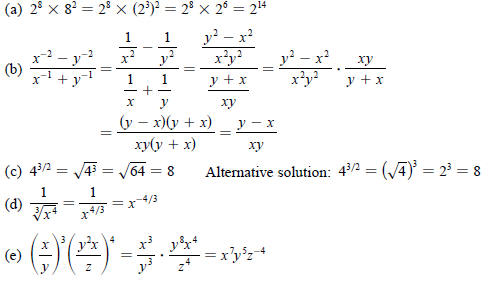
Exercises
1–16 Expand and simplify
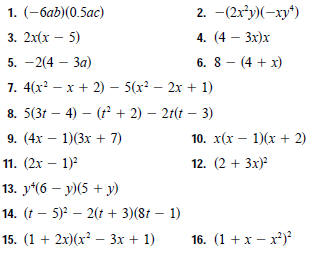
17–28 Perform the indicated operations and simplify.
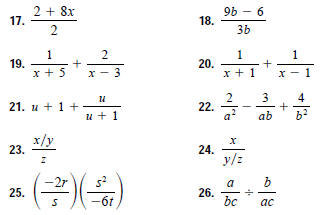

29–48 Factor the expression.

49–54 Simplify the expression.
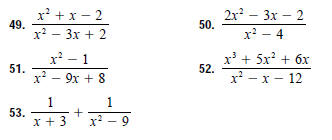

55–60 Complete the square.

61–68 Solve the equation

69–72 Which of the quadratics are irreducible?

73–76 Use the Binomial Theorem to expand the expression.

77–82 Simplify the radicals.

83–100 Use the Laws of Exponents to rewrite and simplify
the expression.

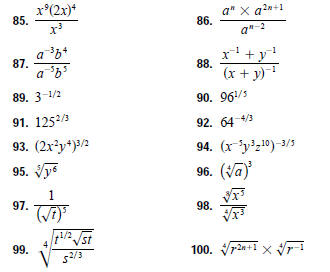
101–108 Rationalize the expression.
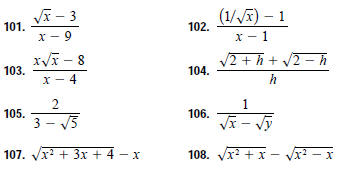
109–116 State whether or not the equation is true for all
values of the variable.
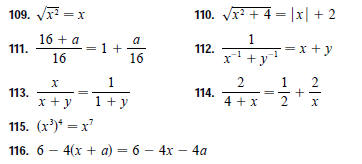
Answers

